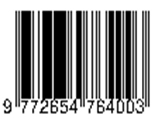EFFECT OF IMMERSION TYPE III GYPSUM IN SODIUM HYPOCHLORITE AND POVIDONE-IODINE SOLUTIONS ON THE NUMBER OF CANDIDA ALBICANS COLONIES
Abstract
Keywords
Full Text:
PDFReferences
Siampa F, Alexes, Samad R. Penerapan Proteksi Dokter Gigi Sebagai Upaya Pencegahan Terhadap Infeksi Silang: Penelitian Di Kota Makassar. Makassar Dental Journal. 2012. 3(1): 1-7.
Kustantiningtyastuti D, Afwardi, Cryniken S. Efek Imbibisi Perendaman Bahan Cetak Hidrokoloid Irreversible Alginate dalam Larutan Sodium Hypochlorite. Cakradonya Dent J 2016; 8(2): 92-97.
Afrina, Nasution AI, Sabila CI. Gambaran Morfologi Candida albicans setelah Terpapar Ekstrak Serai (Cymbopogon citratus) pada Berbagai Konsentrasi. Cakradonya Dent J 2017; 9(2): 107-115.
Zilinskas J, Junevicius J, Romanaite A, Pavilonis A, Gleiznys A, Sakalauskiene J. Viability changes: microbiological analysis of dental casts. Med Sci Monit 2014;20:932-7. DOI: 10.12659/MSM.890500.
Siregar A, Ridaryanti, Dahar E. Efektivitas penggunaan microwave sebagai desinfeksi modal kerja pembuatan gigi tiruan terhadap jumlah staphylococcus aureus dan kekuatan kompresi. Jurnal Kedokteran Gigi Universitas padjajaran.. 2019. 31(2): 135-142.
Widyawati H, Untara T, Hadriyanto W. Pengaruh Berbagai Konsentrasi Larutan Irigasi Sodium Hipoklorit terhadap Kekerasan Mikro Dentin pada Tiga Segmen Saluran Akar Yang Berbeda. Journal Kedokteran gigi, 2013. 4(2): 81-87.
Hamijaya L, Prihatiningsih, Widiastuti MG. Perbedaan Daya Anti Bakteri Tetrachlorodecaoxide, Povidone Iodine, dan Hydrogen Peroksida (H2O2) terhadap Bakteri Pseudomonas Aeruginosa Secara Invitro. Journal Kedokteran gigi, 2014. 5(4): 329-325.
Noviyandri PR, Nurhadisah, Chismirina S. Effect of Nutmeg Flesh (Myristica fragrans Houtt) Against Streptococcus mutans Growth. Jurnal of Syiah Kuala Dentistry Society. 2020; 5(1): 42-46.
Syaula Y, Antari AL, Purbaningrum DA. Pengaruh Perendaman Ekstrak Bunga Sepatu (Hibiscus rosa sinesis l.) terhadap Pertumbuhan Candida albicans pada Plat Akrilik. E-Gigi. 2021; 9(2):159-166.
El Sayed M, Ghanerad N, Shabanpour Z, Shabanpoor M & Rahimi F. Comparing The Anifungal Effect of Sodium Hypochlorite Gel Versus Different Types of Root Canal Medicaments at Different Time Intervals Using The Agar Diffusion Test: An In Vitro Study. International Journal of Dentistry. 2021: 1-10.
Putri S, Djamal A, Rahmatini & Ilmiawati C. Perbandingan Daya Hambat Larutan Antiseptik Povidone Iodine dengan Ekstrak Daun Sirih terhadap Candida albicans secara Invitro. Jurnal Kesehatan Andalas. 2015. 4(3): 962-966.
Dugal S, Chaudhary A. Formulation And In Vitro of Niosomal Povidone Iodine Carriers Against Candida Albicans. International Journal of Pharmacy and Pharmaceutical Sciences. 2013. 5(3).
Rondhianto wantiyah & Islaha A. Perbedaan Penggunaan Povidone Iodine dengan Nacl 0,9% sebagai Dekontaminasi Oral terhadap Kolonisasi Staphylococcus Aureus pada Pasien Post Operasi dengan General Anesthesia di Ruang Mawar RSUD DR. Abdoer Rahim Situbondo. Jurnal Keperawatan. 2015. 6(1): 34-42.
Sinaredi B, Rizki, Pradopo S & Wibowo TB. Daya Antibakteri Obat Kumur Chlorhexidine, Povidone Iodine, Fluoride Suplementasi Zinc terhadap Streptococcus Mutans dan Porphyromonas Gingivalis. Dental Journal (Majalah Kedokteran Gigi). 2014. 47(4): 211-214.
Aipipidely IY, Wowor VNS, Abidjulu J. Perubahan Kekuatan Kompresi Dental Plaster yang Dicampur dengan NaCl dalam Berbagai Variasi Konsentrasi. e-GIGI. 2021. Vol. 2 No. 1.
Inayati E, Redjeki S, Gofur NRP. Prevention and Control of Cross Infection at Dental Laboratories in East Java Province of Indonesia. Journal of Vocasional Health Studies. 2021. Vol 4: 125-130.
Komariah RS. Kolonisasi Candida dalam Rongga Mulut. Majalah Kedokteran FK UKI 2012 Vol XXVIII No.1.
DOI: https://doi.org/10.33854/jbd.v10i1.1366
DOI (PDF): https://doi.org/10.33854/jbd.v10i1.1366.g479
Refbacks
- There are currently no refbacks.
Copyright (c) 2023 Moh. Basroni Rizal

This work is licensed under a Creative Commons Attribution-NonCommercial-ShareAlike 4.0 International License.




